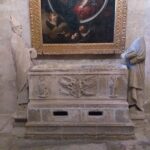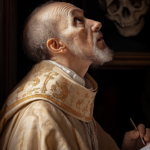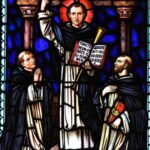St. Magnus
Saint Magnus
Are saints born or made? Take your time before you answer the question.
I believe saints are people with ambition for something bigger than themselves. If you read to the end, you will be able to answer the question.
St. Magnus – Patron Saint of the Orkney Islands
When they lived: St. Magnus, also known as Magnus Erlendsson, lived during the 12th century. He was born around 1075 and died in 1117.
Where they lived: St. Magnus lived in the Orkney Islands, which are located off the northeastern coast of Scotland.
Notable world events during the time of their life:
- The First Crusade (1096-1099): The First Crusade was a significant religious and military campaign launched by Western European Christians to reclaim the Holy Land from Muslim control. This event had profound implications for the political and cultural landscape of Europe and the Middle East.
- The Battle of Hastings (1066): Although this event occurred before St. Magnus’ birth, its impact continued to shape the political dynamics in England and beyond during his lifetime. The Norman Conquest of England led by William the Conqueror had lasting effects on English culture and language.
- The Investiture Controversy (1075-1122): This was a power struggle between the Pope and secular rulers over the right to appoint bishops and other church officials. It had significant implications for the balance of power between church and state during St. Magnus’ time.
- The Age of Enlightenment: Although the Age of Enlightenment started in the 17th century, its roots can be traced back to the medieval period. During St. Magnus’ lifetime, the seeds of scientific inquiry and rational thought were being sown, laying the groundwork for future scientific discoveries and intellectual advancements.
Their patronage: St. Magnus is considered the patron saint of the Orkney Islands, where he is venerated for his piety, compassion, and peacemaking efforts. He is also associated with sailors and those seeking protection from storms at sea.
An Aristocratic Heritage
Magnus was a boy born into a wealthy aristocratic family in Orkney, the United Kingdom. His grandparents were Earl Thorfin and his wife, Ingibiorg Finnsdottir (related to kings Olav 11 and Harald 11 of Norway).
Magnus was born in the year 1080 as the first son of Erlend Thorfinnsson, Earl of Orkney, and Thora, daughter of Sumarlidi Ospaksson of Iceland. He had a brother, Erling, and two sisters, Gunhild and Cecilia.
There is no doubt how glamorous and affluent the Magnus family was in that era. As a boy born in such luxury, he had a good beginning, attended the best schools, and specialized in holy writings.
Thorn of Power
St. Magnus’ father, Erlend, had a twin brother called Paul (Paal), with whom they both ruled in peace as earls of Orkney till their children grew up.
Then came Hakon Paulsson, a cousin to Magnus and his siblings. Hakon believed he was the most excellent of the cousins and deserved to be seen as the foremost among his kin, but St. Magnus’ younger brother, Erling, would have none of that.
Rivalry broke out between the cousins Erling and Haakon. According to the book “Magnus Saga,”, Erling and Haakon were described as talented but quarrelsome and arrogant. On the other hand, St. Magnus was described as quiet and peaceful, not particularly interested in the early kingdom.
St. Magnus’s father and his twin brother Paul tried mediating between the warring cousins but failed. Both of them bear a sentimental attachment to promoting the interests of their son.
Finally, the earldom had to be divided into two distinctive territories. Haakon traveled to Scandinavia, where he stayed with another cousin, Magnus Barefoot, King of Norway. It appeared that peace had returned to Orkney.
The Outcast?
In Haakon’s absence, his father Paul had left mainly control of the kingdom to Erlend and his sons (St. Magnus’ father). The people of Orkney enjoyed the peace and wished for Haakon to never return.
On getting wind of the happenings in Orkney, Haakon sought the help of King Magnus of Norway to help him take Orkney for himself in the battle of 1098. His betrayal was to become his downfall, as King Magnus had other plans.
With Haakon, King Magnus conquered Orkney and took possession of Orkney for himself and his 8-year-old son. Contrary to the agreement he had with Haakon to make him the earl of Orkney.
King Magnus deposed the twins Erlend and Paul and sent them to Norway, where they died as prisoners. He took St. Magnus, his brother Erling, and their cousin Haakon as hostages to serve him.
While on a raiding expedition along the west coast of Scotland, King Magnus brought his cousins along to fight for him. St. Magnus refused to fight the Vikings and instead remained on the ship, singing psalms. His refusal was viewed as cowardice by the Norwegians.
When his younger brother Erling died while fighting the Vikings on the raid expedition, St. Magnus was forced to steal away from the ship and flee into Scotland.
Bridging the Gulf Again
Years passed by, King Magnus died in one of his many raids, and Haakon, St. Magnus’s cousin, gained control of Orkney again. St. Magnus returned to Orkney in 1105, seven years after he sought refuge in Scotland.
On his return, he was granted the earldom, and he ruled jointly in peace with his cousin Haakon till the year 1114.
Again, things fall apart.
It is on record that the followers of St. Magnus and Haakon fell out and were ready to go to war. This became a tremendous burden on the peace that had been long fought and won.
After mediation, it was agreed that the two earls Earl Magnus and Earl Haakon should come together on the island of Egislay with just two ships. An agreement was honored by St. Magnus, but not by his cousin Haakon, who came with eight ships and was tightly armed for battle.
St. Magnus hid all night in a church nearby when he realized that he had been betrayed by his cousin. The followers of Haakon searched for him and captured him in the morning. Magnus offered to go into exile or prison for peace to reign.
But, in a world with so many voices, Haakon’s chieftains kept telling him to kill Magnus as they were tired of joint rule. And Haakon heeded their words.
On Easter Sunday, April 16, 1117, Lifolf Haakon’s cook, on his order, killed St. Magnus with an ax to his head.
Reference:[https://scotscollege.org/saints-of-scotland-st-magnus/]{.ul}
5 Interesting Facts About Saint Magnus
- Did you know St. Magnus is honored as the patron saint of Orkney?
Why? After his death, his cousin was filled with grief and repented.
of his sins, even went on a pilgrimage to Rome, after which he
became the best leader of Orkney and ruled in peace. - Who would have believed that there is courage in cowardice? By
refusing to shed the innocent blood of the Vikings against the king
Magnus’s wishes, St. Magnus showed that courage and strength could
be found in simple things. - He showed an example of authentic leadership by laying down his life.
willingly to restore peace to Orkney. - Have you seen a saint with a great combination of humility and confidence?
Look up to St. Magnus. - St. Magnus showed empathy even in death. He prayed for his
executioners.
Prayer to Saint Magnus
May the precious merits of thy martyr St. Magnus protect us, O Lord, by preaching the works of thy majesty, and may we receive thine aid both now and forever. St. Magnus, pray for us.



